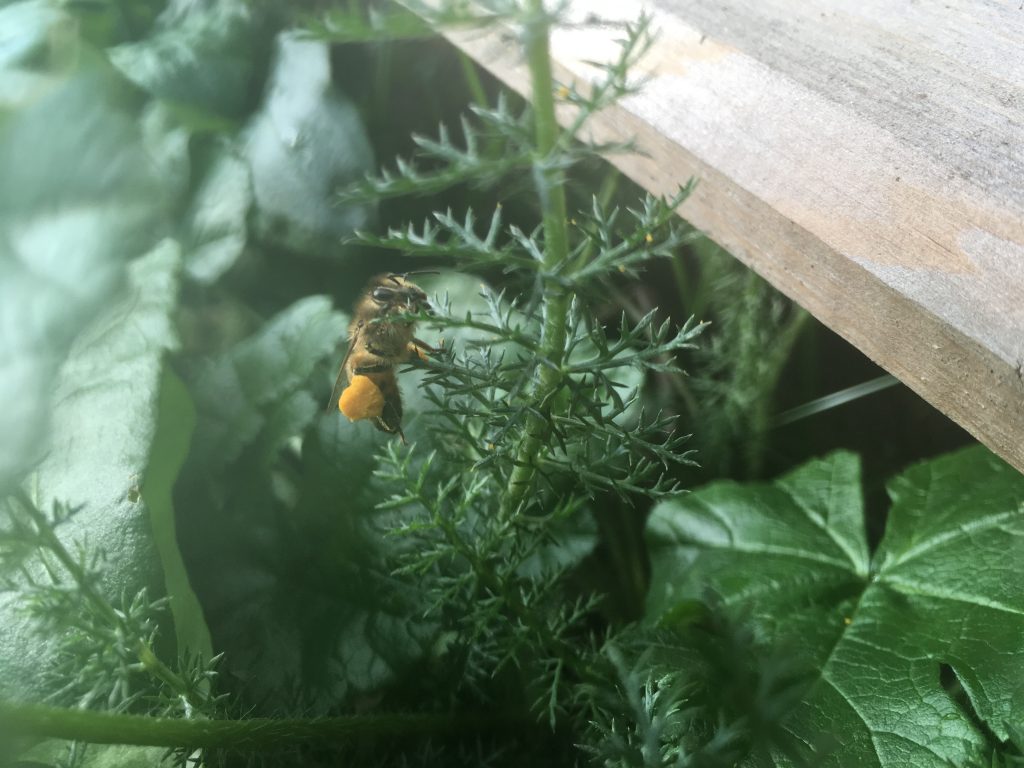‘If the bee disappeared off the surface of the globe then man would only have four years of life left. No more bees, no more pollination, no more plants, no more animals, no more man.’ (Erroneously attributed to Einstein)

“100 years ago there were around 1million bee hives; this had reduced to 400,000 in the 1950s and further reduced to the 274,000 today. It is estimated for the UK that the pollination services from honey bees are worth £120-200 million annually and honey production is worth an additional £10-30 million (Defra, 2008). The feral honey bee population is reported to have been largely wiped out by disease in the last 15 years.”
(Sept 2008, Report to National audit Office, Imperial College London; see this link for more information. https://www.nao.org.uk/wp-content/uploads/2009/03/0809288_honeybee_health.pdf)
The reduction in numbers of the honey bee has been attributed to various diseases, the use of pesticides, monoculture and other changes in agricultural practice resulting in lack of foraging. It is currently trendy to plant wildflowers species for bees and ‘planting for bees’ has become a lucrative marketing strategy.
Beekeepers are well aware of, if only anecdotally, the phenomenon known as ‘The June Gap’ – a crucial time for beekeeping, seen in the United Kingdom and Ireland, when nectar and pollen may be in short supply. For a good crop of honey, you need to have plants around your garden that supply your bees with what they need. This also applies to all native insects that depend on nectar and pollen as a food source. Following the mass of pollen and nectar produced by trees and hedges in spring and a glut of rapeseed flowers in May, grasses and dandelions can suppress many wildflowers so there is a reduction in the amount of nectar available to bees. A single mature lime or willow tree will yield the same amount of bee food as an acre of wildflower meadow but from June, this often tends to be all over, depending on the weather.
Before the herbaceous ‘summer rush’ (July to September) which restores higher levels of nectar (garden flowers, brambles, ivy) the high hive populations bred during spring, struggle to produce honey and may lay fewer eggs. Many honey bees starve during this time if not managed well and presumably, other wild bee types too but no-one is monitoring their honey flow and brood production in quite the same way.
As Landscape Architects, we are in a prime position to ensure large areas of trees and other planting adequately covers the ‘June Gap’. Like Homo sapiens, bees rely on a variety of amino acids for cell function and structure. Bees obtain amino acids from pollen and it has been shown that if you feed honey bees with only one type of pollen (i.e. monoculture), the queen can stop laying eggs completely. So a wide variety of plant species is vital for bee health and colony growth. Bees fly for 3 miles which gives them 18,000 acres for foraging. One single colony, which rises from 15,000 to 60,000 bees in summer, visits millions of flowers to collect 15-55g pollen and 120kg nectar to survive.
Useful plants providing pollen for ‘The June Gap’ include:
- Trees – Acer pseudoplatanus, Aesculus hippocastanum, Cercis siliquastrum, Crataegus, Gleditsia triacanthos, Ilex aquifolium, Liriodendron tulipifera, Mespilus germanica, Rhus, Robinia pseudoacacia, Sorbus aucuparia, Sorbus x intermedia, Tamarix, Tilia
- Shrubs – Ceanothus, Centaurea, Cistus, Cornus, Non-invasive Cotoneaster, Erica, Escallonia, Fuchsia magellanica, Hebe, Hydrangea anomala subsp. petiolaris, Lavandula, Nepeta, Philadelphus, Potentilla, Prunus laurocerasus, Pyracantha coccinea, Rosa (simple single petal or ‘dog roses’), Syringa, Ulex europaeus, Vaccinium, Weigela
- Herbaceous perennials – Anchusa, hardy Geraniums including the native Geranium pratense, Aquilegia vulgaris, Astrantia, Baptisia, Caltha palustris, Campanula, Convallaria majalis, Erodium, Filipendula ulmaria, Foeniculum vulgare, Fragaria vesca, Geum, Helenium, Hypericum, Hyssopus officinalis, Leucanthemum vulgare, Lupinus, Lythrum salicaria, Malva sylvestris, Paeonia, Persicaria, Polygonatum, Rubus fructicosus, Verbascum, Veronica
Herbs – Salvia, Thymus, Coriandrum sativum, Rosmarinus and, best of all Borago officinalis
Seeds/Native/Agricultural margins – Phacelia (annual seed, perennial), Echium vulgare, Crambe maritima, Daucus carota subsp. carota, Rhinanthus minor, Silene dioica, Trifolium pratense, Trifolium repens, Onobrychis viciifolia, Vicia faba
Climbers – Clematis, Lonicera periclymenum, Parthenocissus quinquefolia, Wisteria sinensis
Bulbs – Allium, Camassia